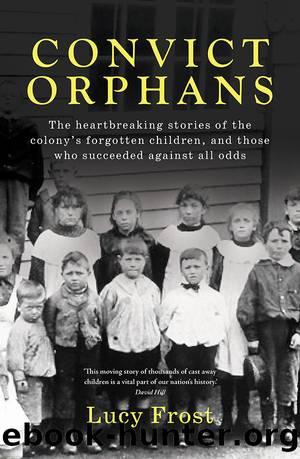Convict Orphans by Lucy Frost

Author:Lucy Frost [Lucy Frost]
Language: eng
Format: epub
Publisher: Allen & Unwin
Published: 2022-12-19T00:00:00+00:00
ILLNESS AND INJURIES
Apprentices who became ill or were injured during the period of their indentures were legally the responsibility of their masters. âIf any person to whom any Apprentice is bound,â read the Queenâs Asylum Act, âfails or neglects ⦠[to provide] medical attendance for such Apprentice ⦠the person so offending shall forfeit and pay a penalty not exceeding Fifty Pounds.â Nothing was said in the act, however, about reporting why medical attention was required, and references to illness or injury are scarce in the surviving correspondence of the Board of Guardians.
Even when apprentices were admitted to hospital, their illnesses went unreported if they recovered and resumed their service. The admission of Mary Ann Phillips only came to light because her master George Boyes had just died, and with her mistress âunable to attend to herâ, Mary Ann went back to the Queenâs Asylum after she was discharged. Another apprentice, âcompletely prostrated by a Rheumatic attackâ, was nursed by her mistress for a month. When it seemed there was âno probability of her present recoveryâ, the guardians agreed to cancel her indentures, as they did for Jane Stankard, who was subject to fits. Jane was lucky. Instead of being re-apprenticed or sent to New Norfolk, she was discharged to her mother and stepfather, who âare willing to take the girl home, in fact are anxious to do soâ.
Some apprentices with chronic illnesses were sent to the Invalid Depot. The illness of Anna Sullivan was not recorded, only the cancellation of her indentures âconsequent upon ill-healthâ: she was âsick in hospitalâ and then âreturned to Depotâ. Elizabeth Smith was readmitted to the orphanage âon account of urinary debilityâ, and re-apprenticed almost immediately. Her new master in Fitzroy Place reported her as an absconder, a girl of ârather stout buildâ dressed in Queenâs Asylum clothes; however, it turned out, according to the Police Gazette, that Elizabeth did not abscond from her service. âShe was left on the road and returned to the Queenâs Asylum.â Where she went from there, the records do not say.
Because the health of children was not routinely checked before they were sent to their placements, and because Angelina Brown âhad never complainedâ, the guardians âsupposedâ she had recovered from scarlet fever before she boarded a coach headed north to an apprenticeship in Launceston. She had not. Her indentures were signed on 1 April 1874, and on 22 Augustâless than five months laterâshe was dead. Her decline can be followed in some detail because her master, Thomas Cook Just, proprietor of the Cornwall Chronicle, was a man given to complaint and accustomed to writing letters.
At the first meeting of the Board of Guardians after Angelina reached Launceston, a letter was read from TC Just, âenclosing a medical certificate, to the effect that the girl lately apprenticed to him was now in the Launceston Hospital too unwell to be at serviceâ. Getting an influential journalist offside worried the board, and its chairman sensibly proposed to âsee the Government with
Download
This site does not store any files on its server. We only index and link to content provided by other sites. Please contact the content providers to delete copyright contents if any and email us, we'll remove relevant links or contents immediately.
Vicious, Elegant Bastards by Hyams Jacky;(183)
A Preface to Politics by Walter Lippmann(123)
Tales from Two Cities by Dervla Murphy(111)
On the Burning of Books by Kenneth Baker(111)
Empires of Panic by Robert Peckham(109)
Simple Living in History by Various Authors Samuel Alexander Amanda McLeod(79)
Mobility and Biography by Sarah Panter(74)
The Oxford Illustrated History of Science by Iwan Rhys Morus(73)
Stories from the Serat Centhini by Santoso Soewito;Pringgoharjono Kestity;(73)
Social Orders and Social Classes in Europe Since 1500 by M. L. Bush(71)
Convict Orphans by Lucy Frost(66)
Tunes on a Penny Whistle: A Derbyshire Childhood by Doris E Coates(64)
Louisiana's Sacred Places by Deborah Burst(51)
Peasants Making History: Living In an English Region 1200-1540 by Christopher Dyer(26)
Volatilization of oxides during oxidation of some superalloys at 1200°C by Unknown(26)
